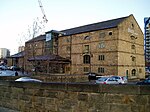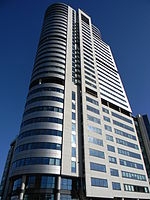Leeds railway station

Leeds railway station (also known as Leeds City railway station) is the mainline railway station serving the city centre of Leeds in West Yorkshire, England. It is the third-busiest railway station in the UK outside London (as of March 2022). It is located on New Station Street to the south of City Square, at the foot of Park Row, behind the landmark Queens Hotel. It is one of 20 stations managed by Network Rail.Leeds is an important hub on the British rail network. The station is the terminus of the Leeds branch of the East Coast Main Line (on which London North Eastern Railway provides high speed inter-city services to London King's Cross every half hour from the station) and is an important stop on the Cross Country Route between Scotland, the Midlands and South West England connecting to major cities such as Birmingham, Glasgow, Edinburgh, Derby, Bristol, Exeter, Plymouth and Penzance. There are also regular inter-city services to major destinations throughout Northern England including Manchester, Liverpool, Newcastle and Sheffield. It is also the terminus for trains running on the scenic Settle & Carlisle line. Future expansion might link the station to the proposed High Speed 2 network. Leeds is a major hub for local and regional destinations across Yorkshire such as to Harrogate, York, Scarborough, Hull, Doncaster and Sheffield. The station lies at the heart of the West Yorkshire Metro commuter network for West Yorkshire providing services to Bradford, Wakefield, Dewsbury, Huddersfield and Halifax. With over 31 million passenger entries and exits between April 2019 and March 2020, Leeds is the second busiest railway station in the North of England after Manchester Piccadilly and the fourth-busiest railway station in the United Kingdom outside London, after Birmingham New Street, Glasgow Central and Manchester Piccadilly.
Excerpt from the Wikipedia article Leeds railway station (License: CC BY-SA 3.0, Authors, Images).Leeds railway station
Neville Street, Leeds Holbeck Urban Village
Geographical coordinates (GPS) Address Phone number Website Nearby Places Show on map
Geographical coordinates (GPS)
| Latitude | Longitude |
|---|---|
| N 53.794 ° | E -1.547 ° |
Address
Hilton Leeds City
Neville Street
LS1 4BX Leeds, Holbeck Urban Village
England, United Kingdom
Open on Google Maps










